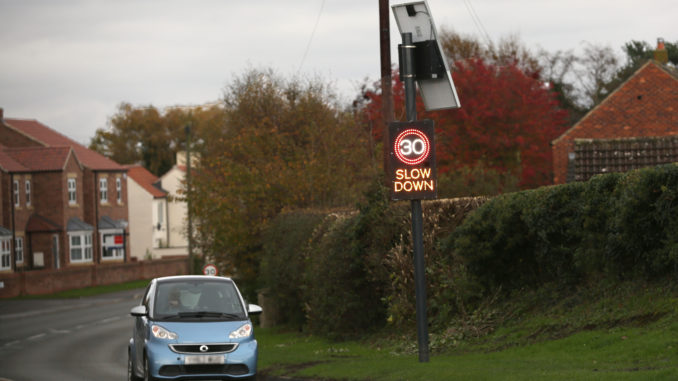
North Yorkshire parishes being granted the power to buy their own vehicle activated signs (VAS) to deter motorists from speeding have been warned they will not be allowed to keep them in one location.
North Yorkshire County Council’s business and transport scrutiny committee heard both parishes and the councillors remained confused over how “permanent” the county would allow the signs to be.
Following mounting pressure from parishes, the council’s executive passed a move last September to allow parishes to buy and erect their own VAS on a site of their choosing, subject to numerous conditions imposed by the county council, such as the site is deemed suitable by highways officers and the sign is an approved one.
Officer Darren Griffiths told the committee leaving the signs in the same place saw the effectiveness of VAS in reducing speeds drop off over time, so they would need to be moved from one location in a parish to another.
He said: “A lot of parishes have come forward already expecting these things to be permanent, to be left in the highway. I think it’s key that they are temporary and are rotated around. We must have a legal agreement to ensure the signs are rotated accordingly.”
The committee’s chairman, Councillor Stanley Lumley said: “I was a little surprised to hear these signs were temporary. I don’t remember that they were going to be temporary. I think the parishes are expecting a permanent fitted sign at the boundaries to their village or wherever the problems are. I don’t think the word temporary has ever been mentioned before through the deliberations.”
The meet heard permanent signs would only be allowed where there was a history of speed-related accidents and that permanent VAS were “a last resort”.
Mr Griffiths said parishes would be offered advice on buying the signs, site preparation and on safety when rotating the signs.
He said parishes would be responsible for funding “everything involved”, from buying and installing the VAS to rotating and maintaining it, undertake a risk assessment and take out public liability insurance.
Mr Griffiths warned: “They work well when they work, but they do fail quite regularly so it is key parishes do have these signs maintained.”
He said no decisions had been made on the maximum number of signs allowed in a parish or the types of VAS that would be approved, but highways officers thought “speed reminder” signs were more effective than speed indicator devices.
The council’s roads boss, Councillor Don Mackenzie said the scheme was scheduled to start in April.
He added: “If there had been an accident record in a village or a parish which needed additional road safety measures we would have taken them. The fact that we are allowing parishes to purchase their own equipment is not an admission on our part that that location is so dangerous it needs that equipment, that is a decision being made by the parish council, probably in response to pressure they are getting from parishioners.
“North Yorkshire County Council’s highway network is intrinsically very safe. The number of people who are injured or killed because of speed-related incidents going through the parishes is tiny. We have far more problems with motorcyclists, with young drivers, old drivers, drunk drivers.”


Be the first to comment